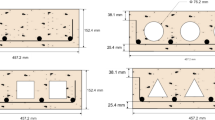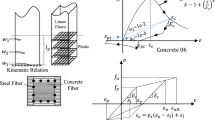Abstract
This study proposes a cylindrical concrete specimen with a small center through-hole for dynamic compression tests at an intermediate strain rate based on theoretical and finite element (FE) analyses. The theoretical analysis demonstrated that the proposed specimen maintained a uniaxial stress state during the compression test. A FE analysis provided the optimum hole size and height of the compression specimen stress, demonstrating a cone-shaped damage distribution inside the specimen at intermediate compression strain rates. The stress, strain, and damage distributions inside the specimen were analyzed by varying its diameter, height, internal hole, and friction coefficient. The height parameter significantly affected the damage distribution, and the center hole eliminated the nonuniform stress on the specimen. The proposed specimen was fabricated using waterjet processing from the original shape suggested by ASTM C39, with the stress–strain curves and fracture shape analyzed using dynamic compression tests.
Graphical abstract
























Similar content being viewed by others
Data availability
The datasets generated during and the current study are available from the corresponding author on reasonable request.
References
A. Talaat, A. Emad, A. Tarek, M. Masbouba, A. Essam, M. Kohail, Factors affecting the results of concrete compression testing: a review. Ain Shams Eng J 12(1), 205–221 (2021)
D. J. Elwell and G. Fu, Compression testing of concrete: cylinders vs. cube, Special Report 119, 21 (1995). Available: https://rosap.ntl.bts.gov/view/dot/38089.
ASTM C39, Standard Test Method for Compressive Strength of Cylindrical Concrete Specimens, Annual Book of ASTM Standards, ASTM International, West Conshohocken, PA, (2015).
R. Kampmann, The influence of the compression interface on the failure behavior and size effect of concrete (The Florida State University, 2012)
A. Carpinteri, G. Ferro, I. Monetto, Scale effects in uniaxially compressed concrete specimens. Mag. Concr. Res. 51(3), 217–225 (1999)
J.G.M. Van Mier, S.P. Shah, M. Arnaud, J.P. Balayssac, A. Bascoul, S. Choi et al., Strain-softening of concrete in uniaxial compression. Mater. Struct. 30(4), 195–209 (1997)
N. Markovich, E. Kochavi, G. Ben-Dor, Calibration of a Concrete Damage Material Model in LS-Dyna for a Wide Range of Concrete Strengths. IWSRIB (2009).
T.H. Lv, X.W. Chen, G. Chen, Analysis on the waveform features of the split Hopkinson pressure bar tests of plain concrete specimen. Int. J. Impact Eng 103, 107–123 (2017)
K. Kyoung-Min, S. Lee, J.-Y. Cho, Effect of maximum coarse aggregate size on dynamic compressive strength of high-strength concrete. Int. J. Impact Eng 125, 107–116 (2019)
S. Lee, K.M. Kim, J. Park, J.Y. Cho, Pure rate effect on the concrete compressive strength in the split Hopkinson pressure bar test. Int. J. Impact Eng 113, 191–202 (2018)
M.J. Forrestal, T.W. Wright, W. Chen, The effect of radial inertia on brittle samples during the split Hopkinson pressure bar test. Int. J. Impact Eng 34(3), 405–411 (2007)
Y. Al-Salloum, T. Almusallam, S.M. Ibrahim, H. Abbas, S. Alsayed, Rate dependent behavior and modeling of concrete based on SHPB experiments. Cem. Concr. Compos. 55, 34–44 (2015)
P. Kelly, Lecture notes: Solid mechanics part II (The University of Auckland, 2013)
J. M. Magallanes, Y. Wu, L. J. Malvar, and J. E. Crawford, Recent improvements to release III of the K&C concrete model, 11th international LS-DYNA Users conference. Vol. 1. No. 3. Livermore Software Technology Corporation Livermore, CA, (2010)
W. Youcai, J. E. Crawford, and J. M. Magallanes, Performance of LS-DYNA concrete constitutive models, 12th International LS-DYNA users conference. Vol. 1. (2012).
Code, CEB-FIP Model. CEB-FIP model code for concrete structures, euro-international committee for concrete, Bulletin 213/214 (1990).
M. L. Javier and J. E. Crawford, Dynamic increase factors for concrete, Naval Facilities Engineering Service Center Port hueneme, CA, (1998).
M. Pajak, The influence of the strain rate on the strength of concrete taking into account the experimental techniques. Arch. Civ. Eng. Enviro. 3, 77–86 (2011)
J. Lubliner, J. Oliver, S. Oller, E. Onate, A plastic-damage model for concrete. Int. J. Solids Struct. 25(3), 299–326 (1989)
L. Jeeho, G.L. Fenves, Plastic-damage model for cyclic loading of concrete structures. J. Eng. Mech. 124(8), 892–900 (1998)
Abaqus User Manual, "Abaqus user manual." Abaqus (2020).
Acknowledgements
This study was supported by the Institute for Korea Spent Nuclear Fuel (iKSNF) and National Research Foundation of Korea (NRF) (Ministry of Science and ICT, MSIT; Grant No. 2021M2E1A1085229).
Author information
Authors and Affiliations
Corresponding author
Rights and permissions
Springer Nature or its licensor (e.g. a society or other partner) holds exclusive rights to this article under a publishing agreement with the author(s) or other rightsholder(s); author self-archiving of the accepted manuscript version of this article is solely governed by the terms of such publishing agreement and applicable law.
About this article
Cite this article
Lee, J., Cho, S.S. Novel concrete specimen geometry for dynamic compression tests. JMST Adv. 6, 75–87 (2024). https://doi.org/10.1007/s42791-023-00061-x
Received:
Revised:
Accepted:
Published:
Issue Date:
DOI: https://doi.org/10.1007/s42791-023-00061-x




